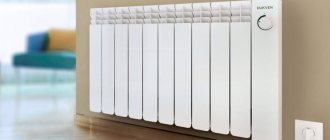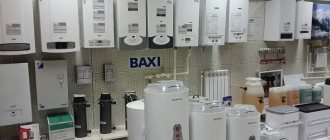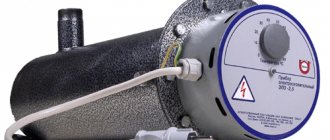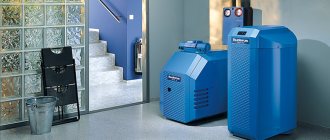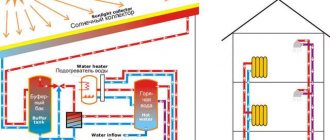Energy prices are steadily rising, so an increasing number of suburban residents are thinking about how to inexpensively and efficiently heat their homes. Most often, homeowners are concerned about what heating options are available for a private home and country house, which boiler has the highest efficiency, which boiler to choose for the heating system, how to properly install the heating system, what types of heating without gas exist and which ones are the most economical.
FORUMHOUSE advises a different approach. First, we decide on the type of fuel, and then we select a heating system “for it.”
From our material you will learn:
- What are the costs of a heating system?
- What type of fuel can be called the most affordable;
- What does a convenient heating system mean?
- Can heating with electricity be cheap?
- What can become the basis of an economical heating system.
Requirements for heating systems of country houses
The general rules adopted by SNiP look quite simple; according to the recommendations of experts, the temperature during the heating period should not fall below 12 degrees. Particular attention is paid to fire safety measures; they will differ for each type of system.
The best location for devices is considered to be under the window openings, and the wiring itself must meet the standards of operational reliability. For air coolant, I advise installing mechanical ventilation, then the result from heating devices will be as efficient as possible. Propylene glycol for the heating system is not prohibited by the rules; this liquid is excellent for various systems.
Ground-to-water heat pumps
These devices are the most versatile alternative sources of heating for suburban households in terms of dependence on the climate zone.
The principle of their operation is based on the fact that even at a depth of several tens of meters in permafrost areas, the soil temperature exceeds zero degrees.
Heat exchangers designed to extract heat from the ground are probes that are immersed in special wells. It requires the laying of pipelines, the length of which exceeds several dozen meters, and in addition to the high price of the pump, the cost of its installation itself is quite high. Thus, drilling one well costs approximately several thousand rubles per linear meter, but more than one is needed. In addition, you still need to install a pump and immerse probes in the well.
It will cost a little less to install a ground-water pump with a horizontally located collector. Heat exchangers are immersed in trenches below the freezing level. The disadvantage of such heating is the large area required to install a heat pump. The resulting heat is spent on heating water for domestic needs and transferring thermal energy to heating devices.
Heating options for a country house with gas
To implement the process, special equipment is often used; the boiler may have an open chamber, in which case air from the room is drawn into it to burn natural fuel.
Combustion products exit through chimneys, but some of their residues will be in the living room, which I would advise to equip with forced ventilation. The positive side of this equipment and the coolant for the heating system of a country house can be safely considered natural draft; electricity is not required for good functioning.
A boiler with a closed chamber is considered no less effective; the working tank does not communicate with the air in the room. But due to the lack of draft, a special drive is required that will pump up the flow to remove combustion products into the chimney; such equipment often depends on the power supply.
Gas heating options
Gas can be supplied to the consumer in two types:
- Using a centralized highway.
- By refueling storage containers located indoors or on the territory of the building (cylinders or gas tanks).
In the first option, the pressure in the system is monitored by a distribution device that works with the main line and the consumer pipeline. After which the fuel is supplied to the heat generator, which ensures autonomous gas heating of the country house. In the second type of natural resource supply, a special reducer is installed, which is responsible for equalizing the gas supply between the container and the combustion point.
Heating with gas holder
Installing such massive equipment will require quite a bit of expense in the first stages of installing heating in a country house; over time, the device will begin to pay for itself, because gas is considered the most economical.
Gas tanks are great for areas where the natural fuel supply line is not installed or is far away, I have seen this quite often in the suburbs. Do not forget about the mandatory equipment of such equipment, this includes:
- Emergency pressure relief valve.
- Gearbox.
- Refill valve.
- Tap for removing condensate from the tank.
- Pressure gauge and fuel level sensor.
Sales of used gas tanks are quite common, I do not recommend purchasing such equipment, because often only the outer walls are restored, and the internal components are 50% damaged by rust. It is equally important before installing the device to think about the access of special vehicles to refuel the tank; this nuance is best decided at the stage of planning the location of the device.
Heating with liquefied gas
I would like to note that without proper insulation and antifreeze for the heating system of a country house, the method of using liquefied gas cylinders will be unprofitable. It will be expensive to use this alternative type of equipment supply if the building area exceeds 200 square meters. m.
Small residential properties up to 70 sq.m. m. can be serviced quite productively with one 50-liter cylinder; taking into account the weather outside, it will last from 2 to 7 days. Therefore, you must have several containers for replacement, so as not to subsequently experience interruptions in heating the house.
Legal nuances of the issue
You can’t just change central heating to an autonomous system. First, you will need to notify the local authorities of your desire in writing and wait for a response from them. Whether it will be positive is unknown. The administration may refer to Art. 190 Federal Law and refuse the tenant’s request.
In court, such a verdict is recognized as unfounded, based on government decree No. 307 of April 16, 2012 , which examines in detail the procedure for connecting heat supply systems. This document describes in detail which local sources of thermal energy are allowed and which are prohibited for installation in apartment buildings.
If a modern boiler is selected for installation and meets the requirements for equipment for installing a home heating system, there is no reason to refuse the installation to the resident.
Documents for obtaining permission
To correctly abandon centralized heating and switch to autonomous heating, you will have to collect a package of documents.
It includes:
- statement about the desired reconstruction of the heating system;
- title documents for ownership of the apartment where it is planned to install new equipment;
- technical passport clearly describing the parameters and layout of the premises (original or notarized copy);
- project for renovating an apartment to accommodate modified heating communications;
- written consent of all residents registered in the apartment;
- expert opinion of the department for the protection of monuments on the admissibility of work on the reconstruction of the premises.
Based on these papers, the authorities issue permission to disconnect the client from city communications.
The process of registration of autonomous heating
To order technical conditions for the installation of individual gas heating, written permission to disconnect the apartment from central communications is sent to the local gas distribution company.
Within 10 days, specialists study the technical feasibility of installing the equipment and give the go-ahead (or refusal) for the actual installation of the system.
Refusal to install a gas boiler due to lack of “technical capability” is allowed only in those areas where there are no gas networks and bottled gas is not available for purchase
When the documents are received, the owners purchase a certified heating boiler and contact the design bureau to prepare an equipment installation diagram, taking into account all technical conditions, safety rules and features of a particular room.
At the same time, the heat supply organization is making a project for correctly disconnecting housing from centralized communications. The basis for the procedure is a letter from the HOA confirming the authorities’ permission to transfer the apartment to an autonomous heating system.
Having all the necessary documentation in hand, property owners go to the fire department and there they receive a certificate confirming the fire safety of the developed project.
The general scheme for transferring an apartment from centralized to autonomous heating is the same everywhere. However, in different areas, due to regional characteristics, additional certificates and documents may be required. You can find out their full list by contacting your local administration.
Then the papers are submitted for approval, and the local administration reviews the application within 45 days, and then allows or prohibits the conversion of the premises for autonomous heating. The reason for refusal is Art. 27 LCD (not a complete package of documents provided). This decision can be appealed in court or, adding the necessary certificates, you can reapply for approval.
Another serious reason is the inability to install a chimney or ventilation system that meets certain requirements.
Heating a country house without gas
Before purchasing equipment and materials for an alternative space heating system, it is worth analyzing the available heat sources. Any system must initially be economically profitable; it is necessary to take into account the costs of installing and launching devices.
I advise you to consider such nuances as:
- Coolant cost.
- Service.
- Planned repairs.
Electric heating of a country house
Operating this type of heating is not difficult; significant costs can only be felt in country houses of medium and large area. Owners of small buildings will be able to use electric heaters quite effectively. The most common types of equipment of this type include the following:
- Thermal curtains.
- Heated floors.
- Heating element electric boilers.
- Oil heaters.
- Ceramic panels.
Some types of devices do not require piping; if the system does not have a boiler, they can simply be installed under window openings, providing only the supply of electricity. Do not forget about fire safety rules, for effective heating of 50 sq. m. with standard ceilings will require up to 8 kW of power, the network cannot be overloaded, otherwise you can get a lot of problems.
Stove solid fuel heating
Solid fuel boilers are not as bulky as old-style stoves; they will be quite “rough” to implement the plan, but the opportunity to make wiring around the house and replace the coolant in the heating system with a more productive one should also not be underestimated.
To equip rooms with radiators and install plastic pipes, you will need a special pump; without it, all attempts to heat the air as much as possible will be in vain. The fuel is often coal and firewood, which can easily be purchased in the required quantities; the only disadvantage of such units will be the abundant accumulation of garbage after the decay of combustion products; the task of throwing it away will seem burdensome after some time.
Diesel heating of a country house
The efficiency of such equipment is quite good, it reaches 85% depending on the brand of the unit and its condition. I noticed that for continuous operation of a diesel heating boiler, 0.9 liters per hour is enough; according to average calculations for the day, the number came out to be 0.7 l/hour. I can’t call the house too small, its area is 100 sq. m. m.
It is better to install this type of equipment in specially designated rooms; the place for the boiler room is thought out first. For maximum safety indicators, ceilings should not be less than 2.2 m, the area should not exceed 4 square meters. m, fresh ventilation should be installed in the room, and the fuel supply should not be increased by more than 800 liters.
Underfloor heating
A fairly good solution for country houses; the wiring can be of several types at the owner’s choice:
- Water.
- Electric.
- Infrared.
Each type of coolant has its own positive and negative sides; a system with liquid will require the installation of an additional boiler, while heating a country house with electricity will be easier to implement; heated floors can operate directly from the network, but repair work related to the cable will cause a lot of problems, after all, they are filled with screed.
Film and rod infrared heating is considered modern, but its cost will not be satisfactory for every owner, as will the maintenance of the equipment.
Heating a country house with a fireplace
This wood-burning heating of a country house will require the installation of air distribution, which will require quite a lot of both construction and finishing work. Fireplaces look noble, they give the atmosphere of the house more coziness and comfort, but I would not consider it as an element for generating coolant in a country house.
If the building is very small, then it will be possible to quickly warm it up, but when the area is impressive, such devices require an additional heat source and will not be an autonomous heating source for a country house.
Heat pump application
This type does not involve burning fuel; only the energy of the earth’s bowels is used. By installing this equipment, you can count on an endless resource, because in the process of heating rooms you only need to monitor the performance of the heat pump for heating and all important components of the system.
Geothermal condensation occurs due to special installations that have high efficiency rates, and energy consumption during operation will be minimal; this factor makes this type of heating system very popular.
Air convector heating
Compared to oil radiators, these units are able to quickly heat the air in the room thanks to the principle of convection. During operation, the device provides cyclic movement of cold and warm air mass.
The equipment is equipped with a heating element, which releases air through a special grille; some models are equipped with fans to forcefully accelerate the circulation of heat in houses with convectors; connection requires only a power supply.
Alternative fuel boilers
When considering all options for units for providing heating in country houses, I often pay attention to electrode equipment; it can be called an absolute novelty in this matter. It is impossible not to mention condensing boilers and induction models of devices.
But it is most practical to install a combined type of equipment in the house, in this case it will be possible to avoid all sorts of nuances in the operation of water heating in a country house.
Types of independent heating units
The most popular autonomous heating units include heating boilers, underfloor heating systems operating on different types of resources, solar panels, collectors and heat pumps. In a private home, you can install any of these heating options or even combine a complex system of 2-3 types of equipment.
A solid fuel boiler is not the most successful option for heating an apartment. For the unit to operate correctly, you must always have a large amount of heating resource on hand (firewood, coal, etc.), and there is simply not enough space for this in standard urban real estate
In an apartment building, the situation is more complicated and the use of most of the above heating units is immediately eliminated for objective reasons.
Some types of equipment cannot be installed in an apartment, either from a technical or practical point of view. The use of others is limited by state and municipal legislation, and others may interfere with the interests and comfortable life of neighbors living nearby.
A water heated floor is an effective heating method, but for heating it takes water from central communications. As a result, neighboring apartments receive less heating resource, but pay for its full volume. Therefore, in the regions, connecting water floors to central systems is prohibited
These nuances significantly narrow the search for suitable equipment, ultimately reducing it to 2-3 heating systems. Each of them has its own specific advantages and small but significant disadvantages.
The choice of the best option occurs individually for each case, taking into account the temperature characteristics of the region, the area and layout of the room to be heated, the availability of heating resources, the specific power and efficiency of the working units, as well as the total cost of installation and installation activities.
Which heating is more economical?
I can say with confidence that heated floors will be the most economical in a country house, because hot air is generated from below and gradually rises upward, uniformly heating the entire area of the room.
Walking on such a surface is very comfortable, especially if the floors are filled with materials that are cold in structure or have tiles on them. To install this type of system, you can use water or antifreeze as a coolant and elements powered by electricity of your choice.
Geothermal installation
Its operating principle is similar to the hydrothermal option. The difference is that the heat of the earth is used, not water.
Equipment Features
Laying the outer contour can be done both vertically and horizontally. The vertical arrangement is due to a number of difficulties during the installation process. For pipes it is necessary to drill wells to great depths. But there are two negative aspects associated with horizontal laying:
- a large area of private land is required to accommodate the circuit;
- it is impossible to plant plants because the collector will cool their roots.
In both cases, heat is taken directly from the soil near a private building. The geothermal pump responsible for pumping the coolant is located in the house itself. The shaft with the heat exchanger should be located in close proximity to the building.
Advantages of using earth's heat
This system has the following advantages:
- The thermal energy of the earth is an inexhaustible source of energy;
- autonomous operation of the system;
- absolute fire safety, no risk of fire;
- minimal energy consumption;
- there is no need for fuel delivery and storage;
- long service life.
The high cost of the object is the main disadvantage. A geothermal installation for the same square footage as in the previous case will increase to 600 thousand rubles.
Schemes of water heating systems
I consider the issue of the cost of one- and two-pipe types of construction not so fundamental; in the opinion of most people, the first heating system will cost less, but only when it comes to small buildings. The second heating circuit will not be able to function as efficiently as possible without thermostatic valves, and slightly more radiators will need to be installed than in the first option.
Single-pipe wiring: pros and cons
An important positive side will be the length of the circuit and the pipeline, because thanks to this indicator they do not affect each other in any way. The connection is quite simple, and the ability to install the system in multi-storey buildings makes it practical. The main pipe looks quite aesthetically pleasing; it is located parallel to the baseboard.
Among the disadvantages, I can note the mandatory installation of additional equipment due to the serial connection of radiators, otherwise the last point will not be able to properly generate heat. This process will affect cash costs, and the heat exchange area will increase.
Advantages of a two-pipe connection:
- Versatility and simplicity.
- Maximum concealed pipe placement.
- Hydraulic balance.
- Possibility to connect many radiators to one coolant.
Heat pumps
Heat pumps are a very real alternative to traditional heat generators and boilers.
The operating principle of this energy-saving system is somewhat reminiscent of an air conditioner, which transfers heat from indoors to outdoors. A heat pump transfers heat from the ground into a heated room and transfers cold back.
When a heat pump operates, energy is not spent on generating heat, but solely on moving it.
Heat pump operation diagram. Click to enlarge.
The functionality of this system makes it possible to obtain approximately 4.5 kW of thermal energy, spending only 1 kW of electrical energy on its transportation.
Heat pumps are highly efficient, reliable and cost-effective. Alternative heating of the described type has only one significant drawback - the decision to install it should be made only at the zero construction cycle.
This requirement is dictated by the large volume of excavation work.
How to make remote control of the heating of a country house with your own hands
The best option would be a GSM socket; I consider this modern device to be the easiest to install to control the heating system yourself. The unit has a built-in temperature sensor, and a maximum load of 4 kW is enough for small country houses.
All radiators must be connected in series, then the device is inserted into a regular socket, the smart heating temperature sensor is able to independently turn off the created system after heating the room to a given temperature, and the owner can do this from any gadget.
Solar panels
Using solar energy for heating is the most inexpensive and accessible way. The main task is to convert sunlight into heat with minimal losses.
System design
The main element of such a system is the solar collector. This is a device consisting of tubes that lead to a coolant reservoir. There are vacuum, air and flat collectors. In addition to them, the composition includes the following units:
- heat exchanger;
- storage tank;
- pipeline;
- front camera.
A storage tank is a container with heated coolant. From the top of the container, liquid is supplied to the heating devices. After passing through the entire heating circuit, the cooled coolant again enters the tank.
The anterior chamber serves to prevent air retention in the heating pipeline. It is a tank that is located at the highest point of the system. Collectors must be installed at an angle of 35–40°. This slope will ensure maximum efficiency. To minimize heat losses, all pipelines leading from the collector to the heat exchanger must be insulated.
Advantages and disadvantages
It is worth noting the main advantages of a solar battery:
- high efficiency;
- long service life - more than 25 years;
- ease of maintenance;
- independence from low air temperatures.
But it is still better to use batteries as an additional source of heat for private homes. In winter, the sun's energy will not be enough to accumulate the required amount of heat. During periods of increased cloudiness, your home may also remain cold. New technologies make it possible to combine several types of heating into one complex, and solar panels can be combined with a geothermal installation or infrared radiation.
Disadvantages also include very high prices for solar collectors and equipment. To heat a 100 m² house, installing solar panels will cost approximately 900,000 rubles.
A short summary
Alternative heating options will help every owner of a modern country property (be it a cottage or a small dacha) to ensure efficient heating of their home and create the most optimal living conditions.
At the same time, despite the rather significant cost of the initial installation of some types of heating systems (for example, heat pumps), the alternative to gas will still be cheaper than the traditional method of heating rooms
And the level of safety of heating systems will be significantly increased by eliminating mains or liquefied gas, which is important, given the number of accidents involving gas systems
Heating boilers
Among the new products in this category that have appeared on the construction market, the following samples can be noted:
induction type boilers operating from the electrical network. These structures are a pipe consisting of a dielectric with a metal core placed inside. They got their name due to the presence of an induction coil wound on top of the pipe. It is this part of the boiler that is the source of energy currents. As a result, the device heats up and transfers thermal energy to the coolant, which, as a rule, is ordinary water. Among the advantages of this model is high productivity, despite its very small size.
In addition, the design of the induction boiler does not have components prone to wear, which is also important; boiler, called an electrode boiler. Its shape is also extremely convenient due to its small size
Heating of the coolant is achieved by placing two electrodes inside it, as a result of which the water, which is an electrolyte, is heated. The peculiarity of this boiler model is that it is completely safe for operation, since if even a minimal leak occurs, the mechanism will immediately stop working due to the principle of its design. However, due to the fact that the functioning of such a boiler directly depends on electricity, its operation can hardly be called economical, since electricity costs will be very significant, despite the assurances of many sellers of this equipment; boilers called condensing boilers. These mechanisms are heating elements that run on gas, or more precisely, on the energy obtained from its combustion. This means that all combustion products condense on a specially designated heat exchange element, due to which it is heated. What makes such boilers notable is that their performance is very high (the efficiency can reach 100% or even more, provided that the total volume of thermal energy released is taken as 100%). The operating principle of such a boiler is based on a process called pyrolysis. Firewood, which serves as the main fuel, burns in two stages. Initially, combustion takes place in conditions of a small amount of oxygen, resulting in the appearance of ash and gas, which subsequently burns in a separate chamber. Thanks to this operating principle, it becomes possible to control the operation of the boiler and distribute heating throughout the entire home as conveniently as possible.
Operating principle of infrared heaters
When studying new technologies in heating, you can immediately pay attention to such a device as an infrared heater. This source of heat energy can be used for both local and widespread heating
This type of equipment is a device that is capable of emitting infrared waves in a certain range. Such waves easily pass through any air barrier and are capable of heating any object that is in close proximity to them.
Operating principle of an infrared heater
For home use, the best models are those that operate on a 220V network. The main component of the device that emits heat is the heating element or open coil. Light waves come from the reflector, and this allows you to heat exactly the space or object at which the device is directed.
Ceiling IR heaters are often used to increase the temperature in rooms such as a garage, utility room, small warehouse and others.
In order to heat the walls of a room, ceiling or floor, you can use infrared innovative film-type heating systems. Such systems can be easily hidden under decoration.
Ceiling infrared heater
Disadvantages and advantages of heating using IR devices
Such modern heating is considered the most suitable and profitable from the point of view of saving energy resources. The efficiency of such a heating system can rise to 95%, plus the room heats up quite quickly. This allows you to optimize all costs as efficiently as possible. One important point to remember is that such modern heating systems for private houses must be additionally equipped with automatic regulators operating on the basis of thermostats.
The infrared heating device is completely safe for both humans and the environment. It does not release toxins or other harmful substances.
Its main disadvantage is considered to be its rather high cost. If you need to install a heating system for the entire building, you will need to spend a lot of money. Of course, these new technologies for heating a private home will fully pay for themselves over time, but not everyone will agree to wait such a long period of time.
Wind generators
Alternative heating systems can produce not only energy such as heat, but also electricity. The current can then be used to heat the room. The most successful example of such a system is a wind generator. It converts electricity into wind energy.
Wind generators are very popular in many European countries. They are used not only at the household level, but also in the production cycle of larger power plants.
Some experts believe that the quality of energy produced by wind turbines does not meet industry norms and standards. Such energy is excellent for converting into heat for the needs of hot water supply and heating systems, which are carried out through heating elements.
Diagram of connecting a wind generator to a heating system using heating elements
Filters: why are they needed?
Often repairing a heating system from blockages is a dubious pleasure and is expensive. It is much better to protect the equipment. Filters protect the system from lime, rust, and scale. This will extend the life of the equipment and prevent sudden repairs. The main thing is not to forget to change them in a timely manner.
There are several types of filters:
| Coarse filter |
| Fine filter |
| Magnetic filter |
Filters are also mechanical and electronic. Their main difference is the size of the particles retained. Electronic models perform deeper cleaning, down to 0.01 microns.
Tips for choosing and installing filters:
— Check whether the filter and system materials are compatible;
— Install in front of the pipe entrance to the boiler or in front of the pump;
— To clean and change filters without problems, install them in a convenient place;
— During the heating season, filters need to be cleaned once every 30-40 days.
